You are using an out of date browser. It may not display this or other websites correctly.
You should upgrade or use an alternative browser.
You should upgrade or use an alternative browser.
Noble Audio Spartacus
- Added by armstrj2
- Create date
Bosk
1000+ Head-Fier
Pros: Fast, bombastic sound with tremendous technical performance
Cons: Aggressive tonality & superb BA bass, but BA bass nonetheless
Once in awhile something special comes along in this hobby, and you usually know it right away.
During a recent visit to my local dealer Addicted to Audio, a staff member happened to mention trying a pre-release Noble Audio earphone called Spartacus, and being floored by its' performance for a relatively modest price by high-end IEM standards.
Having never owned a Noble IEM my curiosity was piqued, but I'll admit to being skeptical the staffer's vaunted praise was warranted - we've all been impressed by an audio gadget that wowed us on first listen, only to later reveal its' flaws.
A fortnight later the chance to try Spartacus came, and it's fair to say I was immediately smitten. Bells started ringing in my ears that this was "the one" and my wallet would've let out a long, mournful sigh if it could've. Spartacus' massive bass & soundstage, coupled with a fast, incisive sound and incredibly rich vocals grabbed me by the collar from the first second.
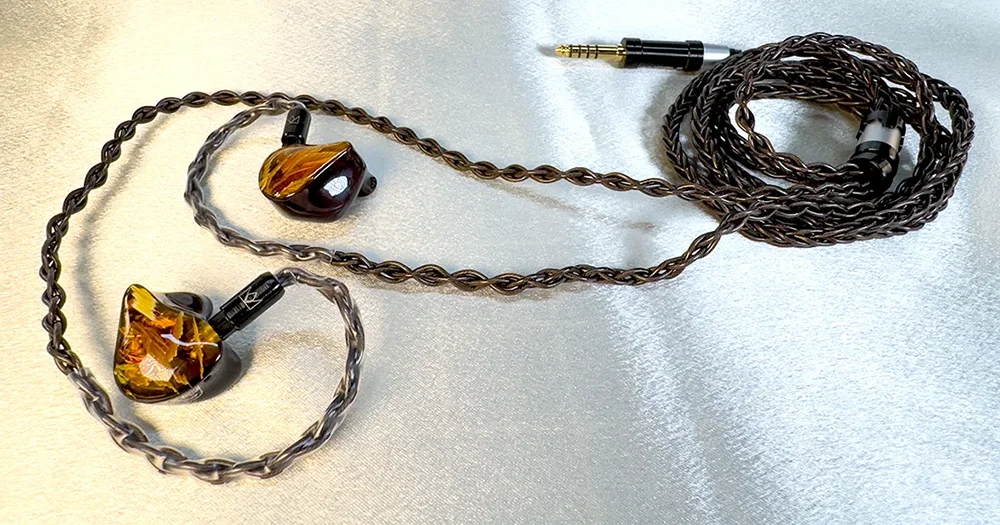
After some friendly negotiations (that may or may not have included me begging) Addicted to Audio generously agreed to provide a discount in exchange for the review you're now reading.
So then, the USD $1799 Noble Audio Spartacus are as visually distinctive with fibre composite faceplates as their 4x BA / 2x BCD driver config is unusual, and I was curious for that reason alone.
They utilise Sonion Bone Conduction Drivers which I'm glad to see becoming prevalent in the market, as prior to acquiring Mest MKIII's I'd never owned a set of BCD earphones but have immediately become a fan. There's something special about BCD imaging & staging which feels almost impossible to duplicate in IEMs without them, and I noted Spartacus contain not one but two BCDs in each earpiece.
Would twin BCDs mean double the magic? With a gleam in my eyes I tore the wrapping off the box, eager to discover the answer!
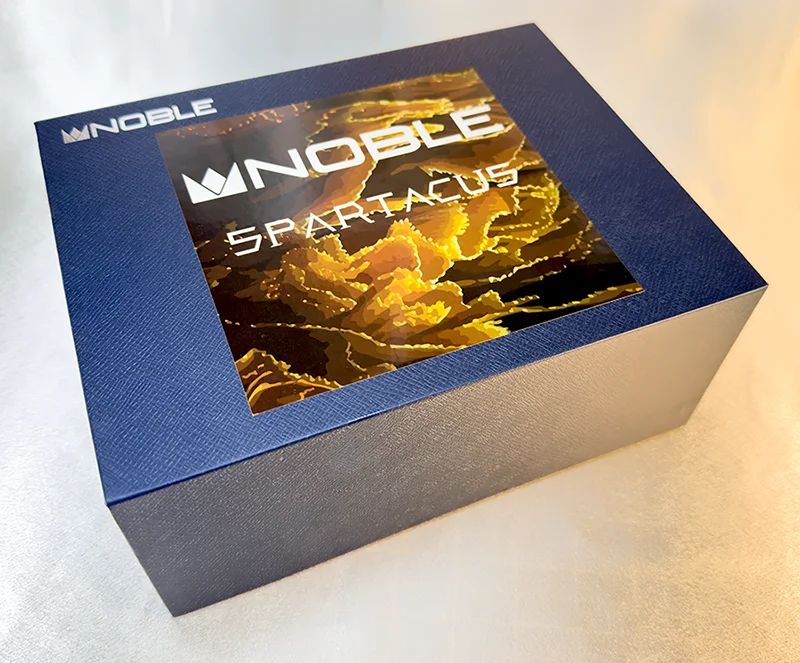
Spartacus arrive in a large, high quality foam-lined composition board box that feels suitably premium.
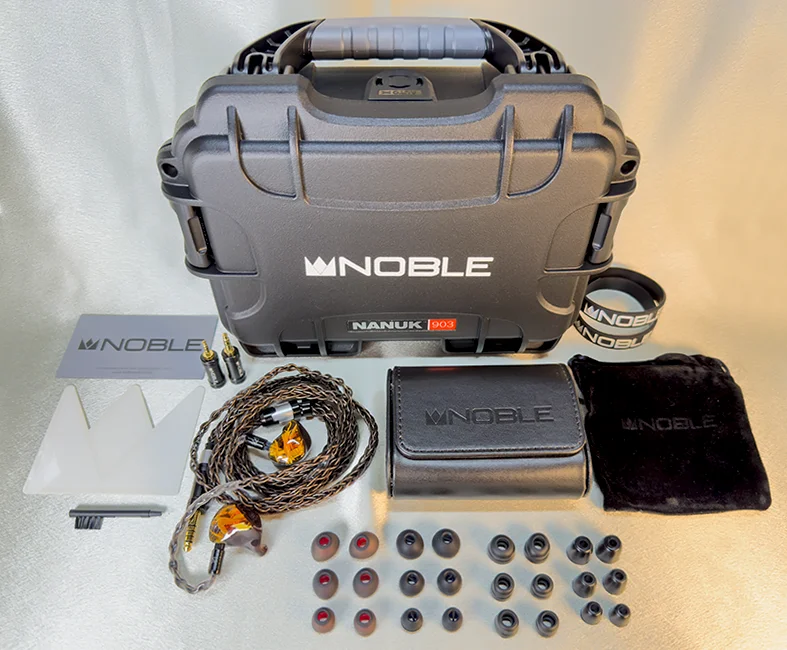
Upon opening the box you'll be greeted with a genuine Nanuk 903 waterproof hardcase that feels like it's been built to house delicate scientific instruments or plutonium fuel rods.
Inside you'll find an assortment of goodies - firstly a velvet drawstring pouch, a small leather carry case, warranty card, Noble emblem sticker, a pair of Noble branded elastic bands for strapping a portable amp to your DAP, a shirt clip, and four sets of eartips in three sizes.
...along with the stuff that matters: The earpieces & stock cable - a modular 8 wire silver-plated copper cable with 4.4, 3.5 & 2.5mm terminations I've since found to be extremely sonically impressive.
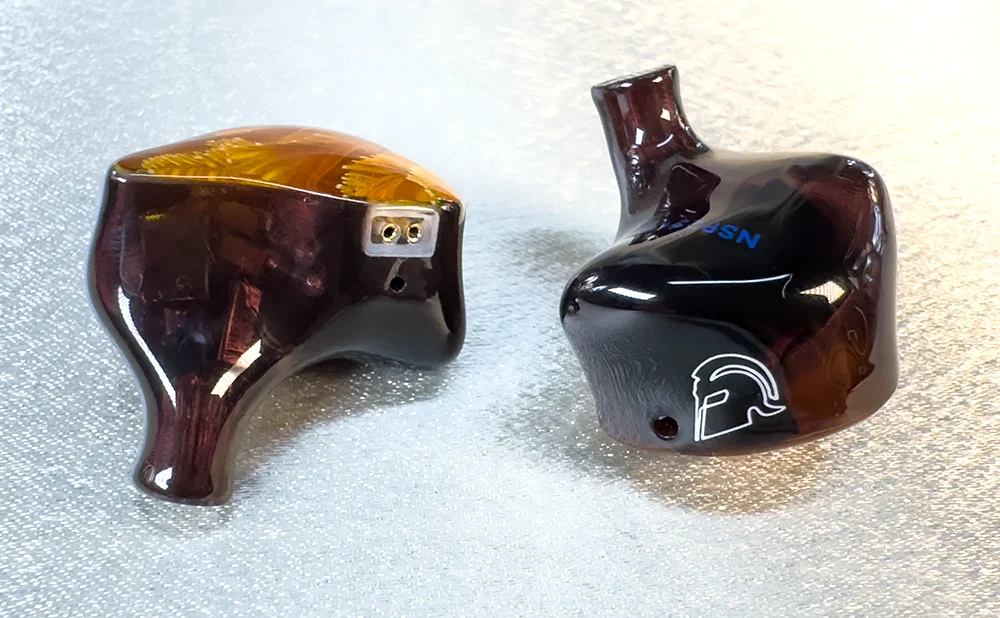
Ergonomically Spartacus are reminiscent of previous Noble Audio IEMs - vented resin shells on the larger end of the scale, but well-sculpted to the natural shape of the human ear.
I was initially concerned size would be a problem, but having lived with them for weeks this hasn't proved to be the case. They're large, and I don't quite forget I'm wearing them as is the case with smaller hybrids, but to my ears they're not uncomfortable.
One consequence of that bulk is they're one of the best-isolating universal earphones I've worn, and the amount of background noise they can drown out on noisy trains lies close to the noise cancellation provided by second generation Airpod Pros.
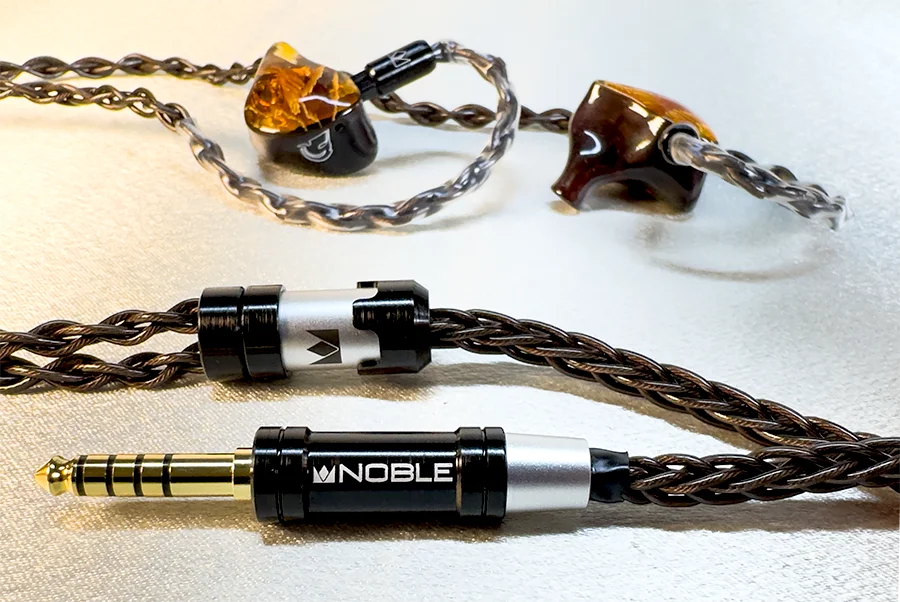
The stock cable feels ergonomically appropriate being a beefy 8 wire affair, yet light enough that I wouldn't say ergonomics are a problem. Effect Audio's Eros S feel similar in girth to this, though thankfully the Spartacus stock cable has a much lighter Y-split.
The modular plug holds in place magnetically, and has thus far given the impression of being better designed than most modular plugs on the market, only detaching unwantedly on very rare occasions.
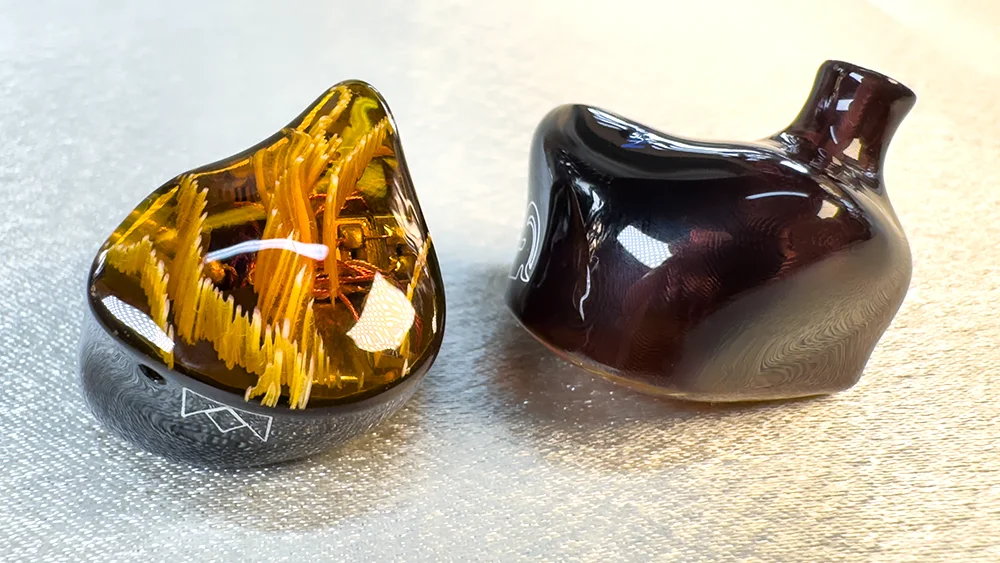
Spartacus delivers a big, muscular sound yet provides all the audiophile niceties you demand. Let's start from the bottom.
Bass is enormously impressive given it's produced by a pair of BA drivers, with highly elevated quantity and seriously impressive texture.
At times I need to remind myself there isn't a dynamic driver in there, and although the slam & rumble can't quite measure up to the best DD-fuellled basshead IEMs, on many tracks I actually prefer Spartacus' bass output to that of Mest MKIII for instance.
In fact at first listen it's easy to get the impression Spartacus is a bass-first IEM where the lower frequencies are prioritised with north-of-neutral quantity, but the more you listen the more you'll marvel at how little has been sacrificed from the rest of the frequency spectrum to achieve this.
Bass is clean in the sense it does not bleed into the midrange, and despite possessing superb texture by BA standards is incredibly responsive so Spartacus will effortlessly keep up with fast-paced music.
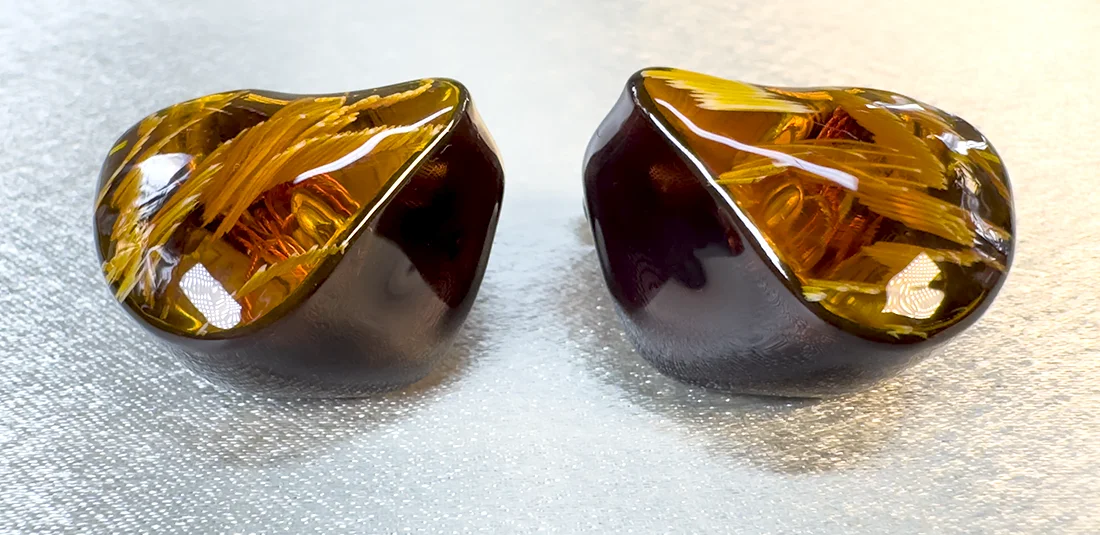
Moving to the middle, Spartacus' midrange has a huge amount of presence and warmth with tremendous resolution worthy of a flagship IEM. Vocals are positioned aggressively forward with impressive note weight, and instruments in general are rendered very large.
Combined with the voluminous bass output, this helps create a bold, brash sound that's loaded with excitement. The downside is if you happen to find forward vocals fatiguing, but for my taste they provide a massive sense of engagement.
Spartacus' lower treble is very prominent, aided by its' silver-plated copper stock cable, so if you're into electronic or classical music like me you won't find Spartacus too dark to do such genres justice.
Having said that, upper treble can at times feel slightly restrained, and though I'm reluctant to label Spartacus' treble a weakness it's definitely an area where some more expensive IEMs are able to render violins with greater delicacy - most commonly those with EST drivers.
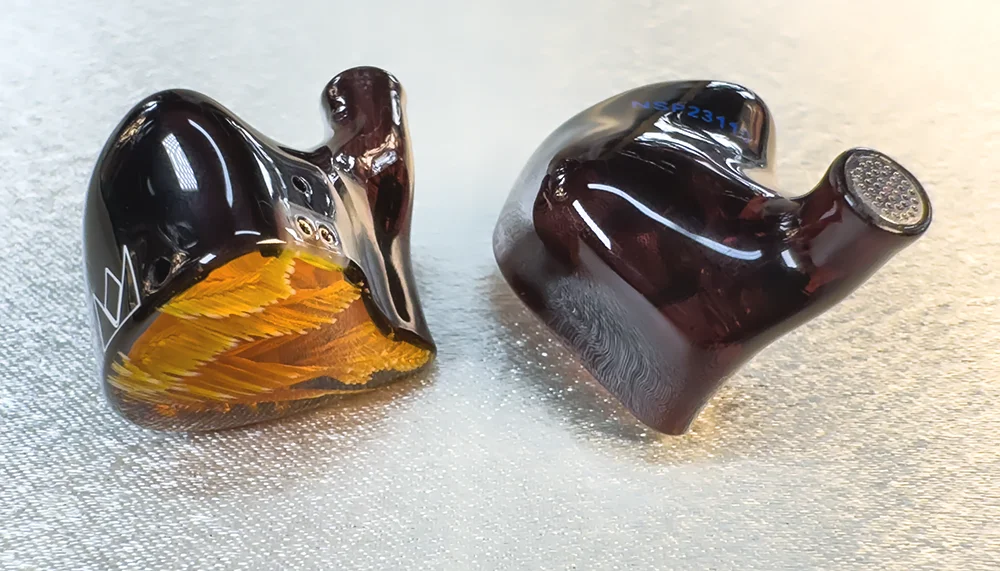
The first thing I notice about Spartacus is the impressive width of their soundstage. It isn't the absolute widest I've ever heard (Elysian Annihilator earns that trophy) it isn't far off, and is a standout attribute.
Stage depth isn't as impressive - slightly above average without being exceptional, though not so shallow as to present itself as a weakness. Actually Spartacus' stage dimensions are somewhat unusual in that it feels like I'm 'looking down' on the stage from slightly above more than normal.
Spartacus' dynamics are nothing short of superb, and greatly contribute to their excitement. Dynamics go a long way towards enhancing my musical enjoyment (a reason I advocate for portable amplifiers which boost this area) and those awesome dynamics help generate Spartacus' bold presentation.
Imaging is very solid without jumping out as special, likely Spartacus' more restrained upper treble is the reason this isn't a greater strength. The addition of EST drivers would've helped, and though I do not hear Spartacus' imaging as deficient it isn't spectacular enough that I'd pick them up purely for the joy of how they render pinpoint instruments in space. Similarly, though their background is acceptably black I wouldn't say its' quite as dark as class-leading IEMs in this area.
Finally, deserving special mention is Spartacus' tremendous speed. Without a dynamic driver to slow things down they're blisteringly quick at rendering complex musical passages cleanly with instruments remaining distinct, yet still delivering a brash & bold presentation with gobs of deep bass.
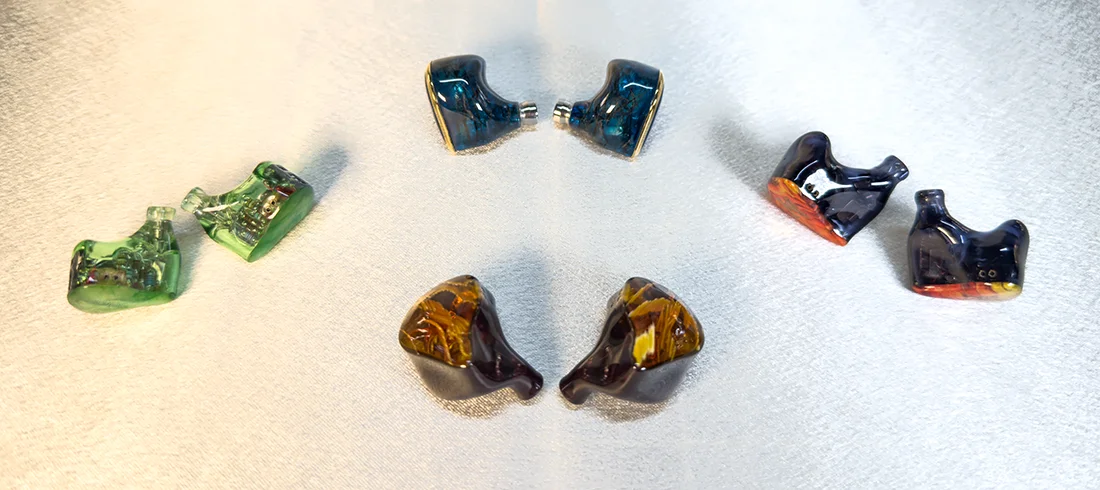
I compared Spartacus with a number of IEMs at hand using the Hiby R6 Pro II I recently reviewed, with Spartacus requiring a volume level of 21 in hi-gain, AB mode.
ISN EST50 (USD $449)

The EST50s are slightly smaller and stick out a bit less. I also find their shells are narrower in the areas near the nozzle that makes contact with my ear so they don’t fit as snugly as Spartacus, which makes them slightly more comfortable but they don’t seal as strongly. Requiring 19 volume on the R6P2 they're similarly easy to drive.
It's immediately obvious the EST50s' DD-fuelled bass is much slower than that of Spartacus and struggles to keep up with fast paced music, but the EST50s' bass does boast more satisfying slam & texture. However the EST50s sound more congested with a soundstage that's both narrower & shallower. They're also darker, with a warmer, lower-resolution presentation that can get a little boomy at times.
Like Spartacus the EST50s are a bass-first IEM, but it feels like so many other aspects of their presentation have been sacrificed to achieve this whereas Spartacus is feels far more open, resolving and refined despite bass quantity being fairly similar.
Penon Turbo (USD $549)

The Turbos are much smaller, lighter & far more comfortable than Spartacus but don't isolate nearly as well thanks to less bulk blocking the ear opening. Requiring 25 volume on the R6P2 they're slightly harder to drive.
The Turbos' are more midbass-emphasised and their bass texture isn't as impressive, feeling a little mushier than that of Spartacus. Turbos' midrange is positioned further back and their overall tonality is more polite than Spartacus' who's midrange is much richer and more forward, but can feel more aggressive as a result. The Turbos are also tuned darker, which is perhaps responsible for their imaging being less defined.
Spartacus definitely have a blacker background with superior dynamics & better note weight, and although they're more resolving the resolution gap isn't massive. Spartacus' soundstage is also wider, and I find their tonality a lot more musical & engaging whereas the Turbos come across as a little more tonally "hi-fi" & artificial.
Unique Melody Mest MKIII (USD $1899)
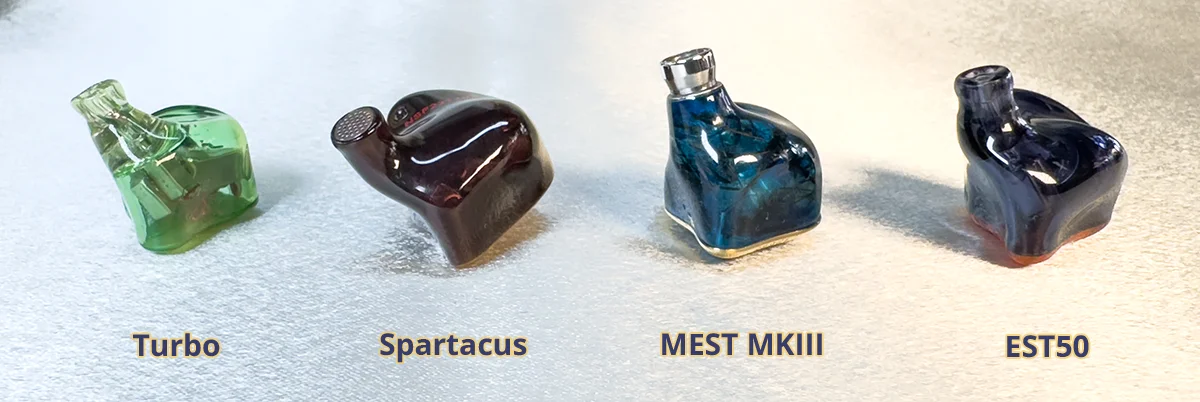
MEST MKIII is about the same size as Spartacus but a little thinner in the section that makes contact with my ear so they're slightly more comfortable but don't isolate as effectively. It must be said the MKIII stock cable has some of the worst ergonomics of any cable I've tried, being especially stiff below the Y-split. Requiring 23 volume on the R6P2 MEST is similarly easy to drive.
MEST MKIII's dynamic driver is much faster than the EST50s' so there isn't the issue of it struggling to keep up, but bass quantity is definitely lower with much less sub bass presence in particular than Spartacus, though MEST's DD bass texture is slightly superior but Spartacus comes awfully close.
MEST's presentation is quite v-shaped and its' weakness is its' midrange, with a cooler tonality that feels fairly thin & emotionally unengaging as opposed to Spartacus' midrange being warmer and much more forward with instruments that sound larger. When it comes to treble the tables are turned, with MEST's much higher quality treble (particularly upper treble) exposing Spartacus' shortcoming in this area.
MEST's stage is deeper with a blacker background but Spartacus' is wider, and though resolution between them is similar it feels like MEST is resolving slightly more detail simply by pushing more treble at me. MEST's imaging does feel marginally more precise, though both IEMs appear to utilise their BCDs really well and I wonder if MEST's slightly higher technical performance is the result of being tuned to prioritise technicality over tonality.
Thieaudio Monarch MKIII (USD $999)
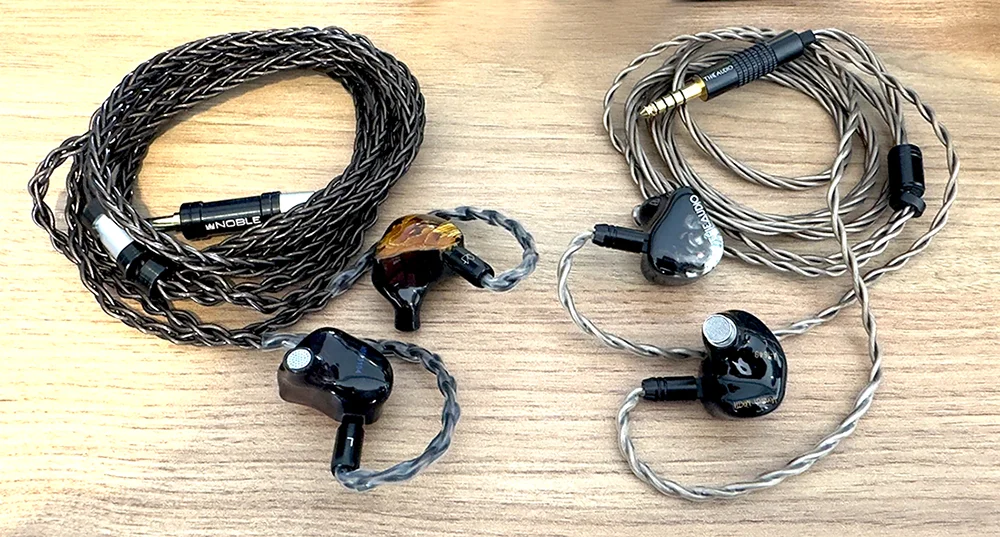
Similarly sized to Spartacus, the Monarch MKIIIs require a volume of 30 on the R6P2 so they're more difficult to drive.
The MKIIIs have less bass quantity than Spartacus with midbass emphasised over sub bass, and overall sound more refined with a smoother presentation that's less warm & visceral than Spartacus. The MKIII's maintain much of the Monarch MKII's flat tonality that's very neutral & uncoloured, but thankfully they are a little more lively this time around.
The soundstage of both IEMs is similarly wide but Spartacus' stage is deeeper, and Spartacus also comes across as brighter with a more forward & aggressively-tuned midrange. Spartacus is perhaps a touch more resolving but the MKIII competes well in this area given its' more modest price.
64 Audio U12T (USD $1799)
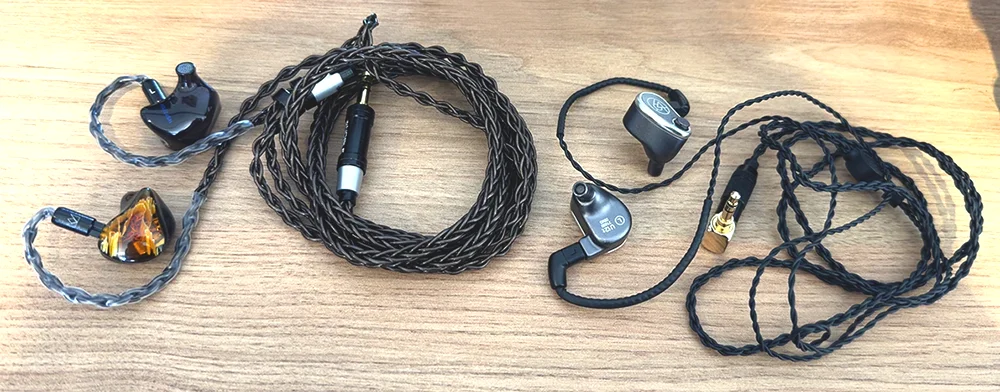
The U12T's shells are far smaller but much less sculpted to fit one's ear geometry, and thanks to their metal construction they're about as heavy as Spartacus. Requiring a volume of 31 from the R6P2's more underpowered 3.5mm jack the U12Ts are similarly easy to drive.
U12T bass quantity is far lower and their bass texture is not as satisfying either, so this feels like an area where Spartacus is considerably more capable. The U12T have a smoother, more neutral presentation and their midrange feels less aggressive & better balanced than Spartacus', however their treble is also more muted which perhaps contributes to accusations of a "boring" tonality some reviews have thrown at them.
Spartacus' stage is deeper and slightly wider, though both IEMs feel similarly resolving. To me the U12Ts stand up really well even in today's market, and I find them more engaging than say the Monarch MKIIIs which perhaps try to emulate a similar sound, but having said direct comparisons to Spartacus definitely have them showing their age.
Fir Audio RN6 (USD $3299)
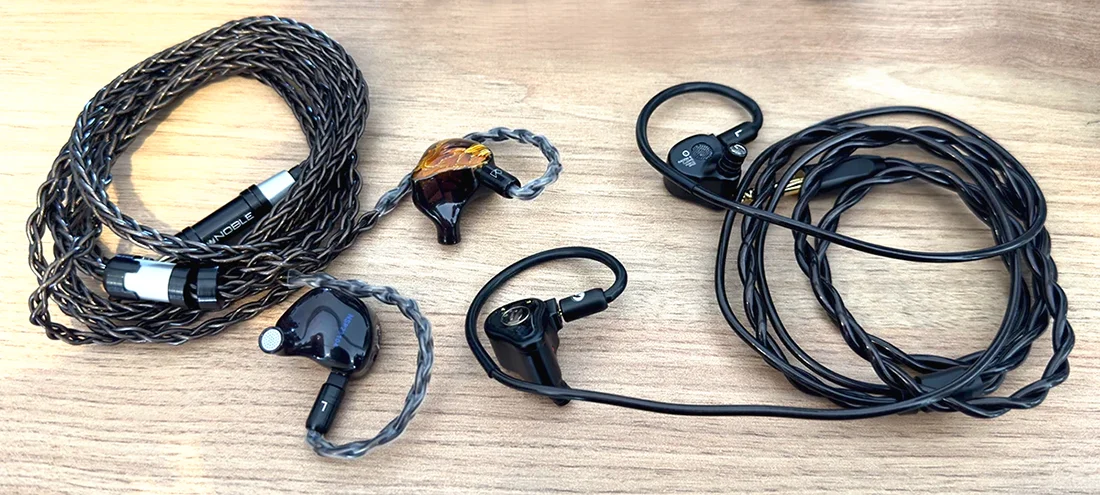
Much like the U12Ts, the RNs' shells are much smaller than Spartacus but less sculpted to one's ears. Requiring 23 volume on the RN6 they're about as easy to drive.
The RN6's feature considerably less bass quantity than Spartacus but their bass quality is excellent. They're fairly midrange-emphasised, and I notice more upper midrange bias on the RN6s whereas Spartacus has a more bodied midrange stemming from its' lower midrange boost. RN6 has a more polite, smoother tonality and is impressively well-balanced overall, with more lower treble present.
RN6's stage is slightly deeper but not quite as wide, though they aren't as dynamic as Spartacus which I find more exciting as a result of their tuning, though RN6 is probably the safer choice for most people.
Noble Audio Ronin (USD $3900)
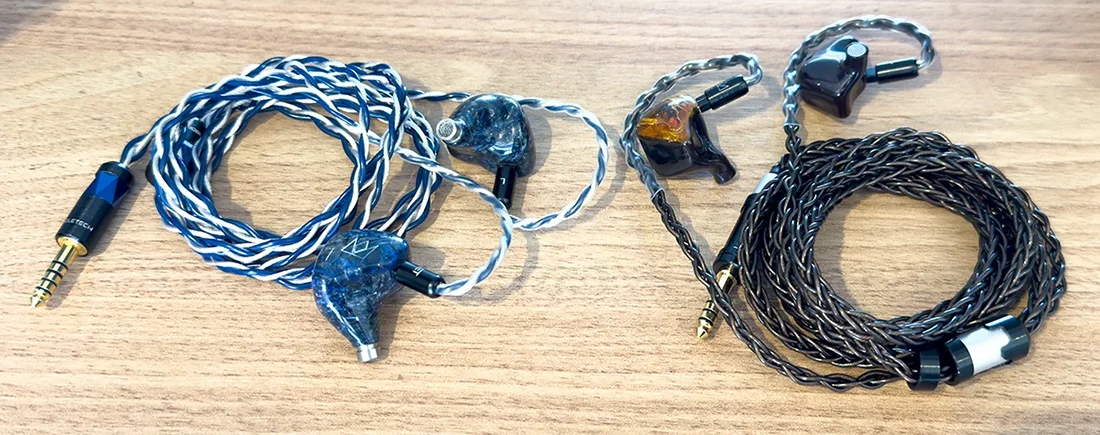
Ronin are physically much larger than Spartacus and stick out a proverbial mile, and though I don't find them uncomfortable they surprisingly don't isolate quite as well as Spartacus. Requiring 23 on the R6P2 they're similarly easy to drive.
Ronin's bass quantity is considerably lower than Spartacus' and is textually a little mushier. Reminiscent of the RN6, Ronin are quite midrange-centric with one of the most spectacularly beautiful midranges I've heard, reminiscent of the Penon Impacts. Treble is less accentuated on Ronin, and despite feeling much more refined than Spartacus I can hear Noble's house sound coming through in both.
Ronin's stage is about as wide but deeper than Spartacus', and both IEMs are similarly dynamic & resolving. Spartacus comes across as more v-shaped and exciting which is a tuning I prefer, but Ronin may prove less fatiguing during long listening sessions.

I recently received a Mass Kobo 475 portable headphone amplifier and have been keen to learn how Spartacus scales with beefier amplification. Having previously owned the Aroma A100TB, ALO Audio Continental Dual Mono and demoed the Cayin C9 & Brise Audio Tsuranagi, I rate the 475 as simply the best portable amp money can buy. It's fully balanced with 4.4mm input & output, and delivers 2.3V RMS from its’ balanced jack.
To make the test more interesting I paired the 475 with the Cayin N8ii, which already possesses one of the most impressive built-in amplifiers of any DAP on the market, and compared Spartacus' performance from the N8ii/475 combo to the N8ii on it's own, set to hi-gain, solid state mode with P+ enabled.
The 475 has a v-shaped tonality, so as expected it transforms Spartacus' bass to feel much larger & more impactful, though I do feel it shift slightly towards a midbass rather than sub bass emphasis. Spartacus' midrange doesn't seem to be altered significantly, but treble is definitely more prominent now which is problematic given Spartacus already leaned towards brightness.
Improvements to technical performance are hugely substantial, which is where 475 comes into its own - Spartacus' soundstage grows in both width and depth, resolution goes up dramatically with tiny nuances rendered more effortlessly, note weight increases, imaging is more precise, dynamics improve, and control during busy passages increases which helps instruments remain distinct when many are playing at once. Many of these are existing Spartacus strengths that are made even stronger.
Admittedly the N8ii isn't the best tonal pairing given it's already quite bright which 475 only accentuates, so a warmer source is recommended if you choose to pair a 475 amp with Spartacus. However the experiment proves Spartacus' driver configuration (lacking dynamic or EST drivers) absolutely does not prevent it scaling massively with better amplification.
Penon Obsidian (USD $149)
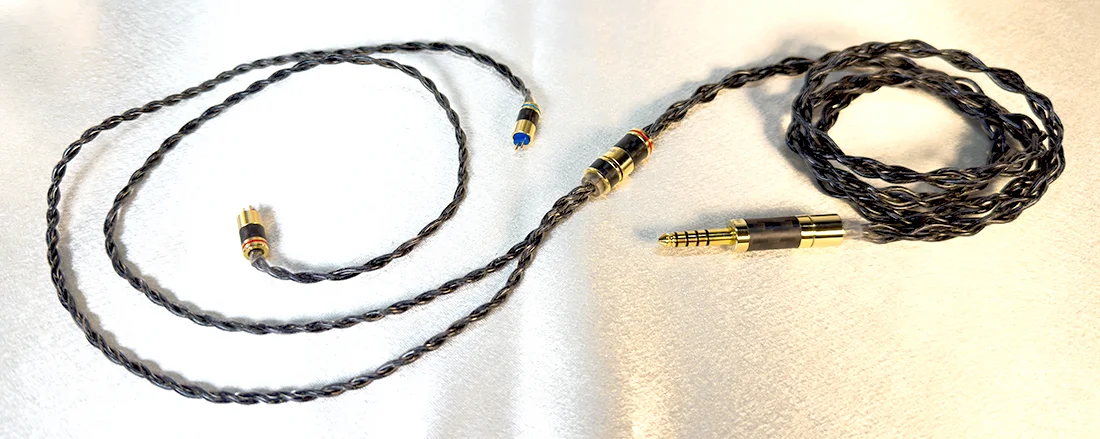
In my recent review of the Obsidian I talked about how this novel modular cable can be sonically tweaked by swapping plugs made from different materials.
With the Purple Copper plug in place the Obsidian creates a warmer sound, with a slightly narrower & flatter stage though imaging does not feel less precise. Bass impact is lower, though tonality has improved as treble feels more restrained than on the stock cable without any perceptive loss of detail.
Swapping to the Rhodium plug this feels closer to stock with added treble presence, now the stage feels slightly wider, sub bass has a bit more impact and background blackness has improved. Rhodium is my preferred plug for Spartacus though I still like the stock cable pairing better.
NiceHCK AceOrpheus (USD $260)
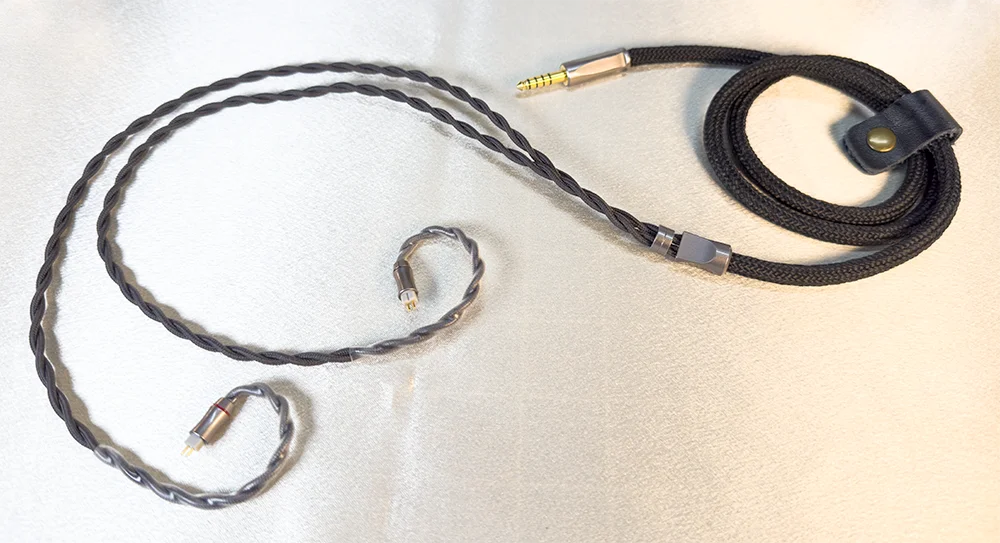
NiceHCK's cheeky branding aside, I'm saddened to report this cable does not match PW Audio's Orpheus at 4% of the price.
AceOrpheus is an interesting cable which almost has a way of slowing down Spartacus' bass to make it feel more analogue, yet bass is definitely more impactful on the stock cable. AceOrpheus feels quite diffuse with vaguer imaging and comes across as a bit wooly, yet it does project a deeper & taller stage that can even make instruments feel larger, although treble is definitely muted.
Everything seems to tighten up going back to the stock cable which also boasts a blacker background, but AceOrpheus does create a sense of scale that's quite unique for such a modestly priced cable - I just wish it weren't so deficient in other areas.
Hakugei Sky-bolt (USD $884)

The Sky-bolt has been my go-to cable for enhancing IEM technical performance for some time now, so my expectations for this pairing were high.
Sky-bolt makes bass actually feel less impactful than on the stock cable, though treble feels more prominent and resolution may correspondingly be slightly higher. Dynamics are less impressive, and although the stage is deeper it doesn't seem much wider, though Sky-bolt does provide the feeling of being seated further back from the performers.
This pairing is disappointing given the dramatic improvement Sky-bolt has made to many other IEMs, but that says something about the impressive technical performance of Spartacus' stock cable.
PW Audio 1950s clone (USD $2149)
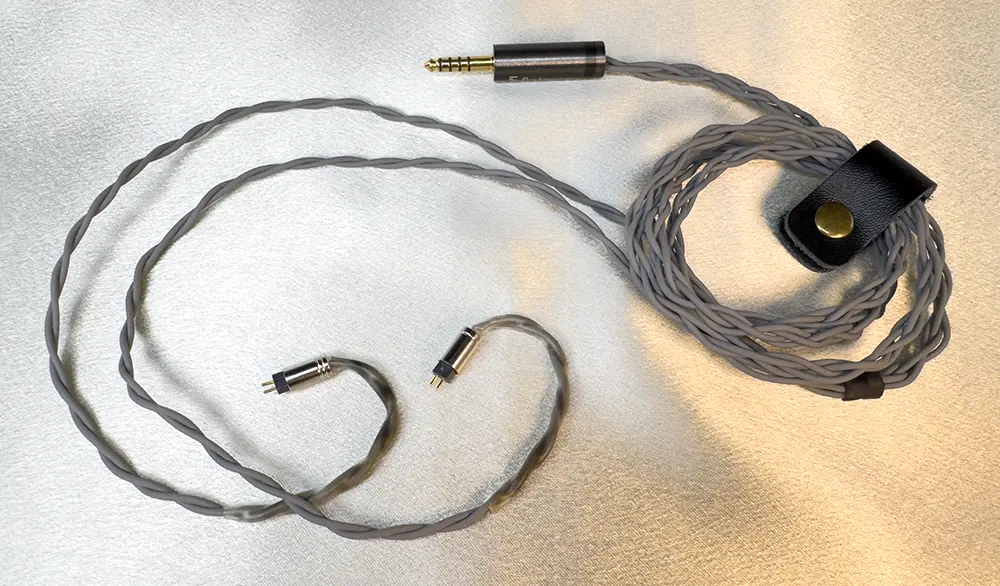
My DIY Cardas Clear clone of PWA's 1950s cable is probably the best all-round cable in my collection, so I was very excited to try it with Spartacus.
Cardas Clear's bass is slightly less impactful than the stock cable's and overall bass feels more tightly integrated into the rest of the presentation, with a smoother tonality that's a bit more polite. High frequencies aren't as sharp & potentially fatiguing as they are on the stock cable either, yet resolution is actually slightly higher on the Cardas Clear - perhaps aided by its' blacker background.
The stock cable's stage is actually slightly wider and although Cardas Clear's is deeper, it really doesn't feel as though the 1950s clone has brought technical performance to a higher level across the board. I do find the 1950s clone less fatiguing, but find the more v-shaped sound of the stock cable more exciting, rendering this cable pairing less successful than its' been with other IEMs.
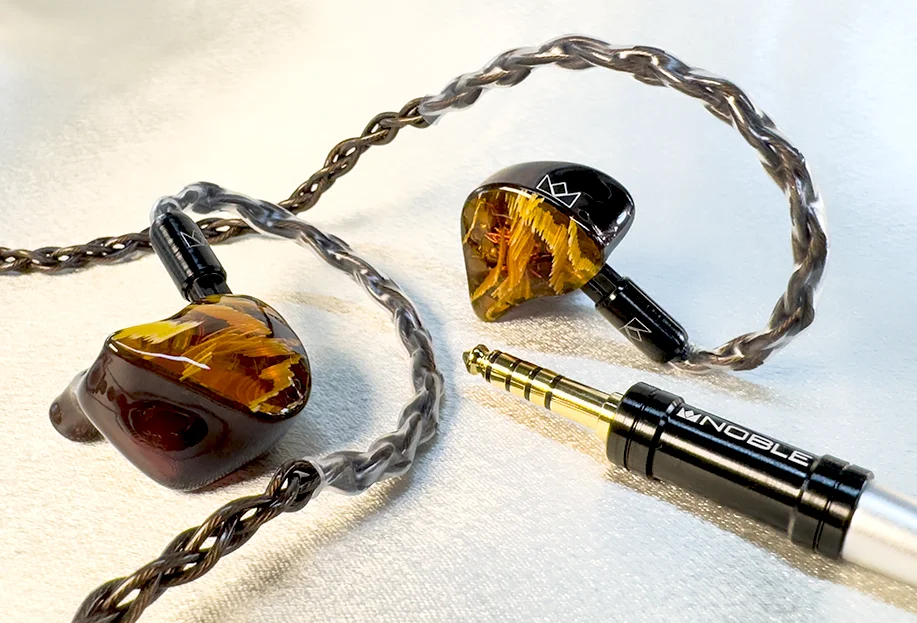
It's tough to be objective in a hobby as subjective as ours, and even harder when you fall madly in love.
Yes, I'm in love. I want to have Spartacus' babies even if that involves growing ovaries.
To my ears they offer the perfect mix of massive bass, incredible resolution, enormous soundstage and a midrange to die for. Most of all though, they're fun. They're bombastic, groovy and in-your-face in a way that earphones with great technical chops generally aren't. They're not trying to be "accurate" or authentic to whatever the artist supposedly intended, they just want you to have a really good time.
It's entirely possible you may not like Spartacus as much as I do. You may insist on your IEMs containing a dynamic driver, or you may find Spartacus a bit too aggressive and prefer something more laidback. There's no way to know except by trying them, and I strongly encourage you to do so.
These are by far my favourite Noble IEMs so far, and I'd love to see them tune more earphones similarly in future. Thanks to Addicted to Audio for making this review possible!
During a recent visit to my local dealer Addicted to Audio, a staff member happened to mention trying a pre-release Noble Audio earphone called Spartacus, and being floored by its' performance for a relatively modest price by high-end IEM standards.
Having never owned a Noble IEM my curiosity was piqued, but I'll admit to being skeptical the staffer's vaunted praise was warranted - we've all been impressed by an audio gadget that wowed us on first listen, only to later reveal its' flaws.
A fortnight later the chance to try Spartacus came, and it's fair to say I was immediately smitten. Bells started ringing in my ears that this was "the one" and my wallet would've let out a long, mournful sigh if it could've. Spartacus' massive bass & soundstage, coupled with a fast, incisive sound and incredibly rich vocals grabbed me by the collar from the first second.

After some friendly negotiations (that may or may not have included me begging) Addicted to Audio generously agreed to provide a discount in exchange for the review you're now reading.
So then, the USD $1799 Noble Audio Spartacus are as visually distinctive with fibre composite faceplates as their 4x BA / 2x BCD driver config is unusual, and I was curious for that reason alone.
They utilise Sonion Bone Conduction Drivers which I'm glad to see becoming prevalent in the market, as prior to acquiring Mest MKIII's I'd never owned a set of BCD earphones but have immediately become a fan. There's something special about BCD imaging & staging which feels almost impossible to duplicate in IEMs without them, and I noted Spartacus contain not one but two BCDs in each earpiece.
Would twin BCDs mean double the magic? With a gleam in my eyes I tore the wrapping off the box, eager to discover the answer!
Packaging

Spartacus arrive in a large, high quality foam-lined composition board box that feels suitably premium.

Upon opening the box you'll be greeted with a genuine Nanuk 903 waterproof hardcase that feels like it's been built to house delicate scientific instruments or plutonium fuel rods.
Inside you'll find an assortment of goodies - firstly a velvet drawstring pouch, a small leather carry case, warranty card, Noble emblem sticker, a pair of Noble branded elastic bands for strapping a portable amp to your DAP, a shirt clip, and four sets of eartips in three sizes.
...along with the stuff that matters: The earpieces & stock cable - a modular 8 wire silver-plated copper cable with 4.4, 3.5 & 2.5mm terminations I've since found to be extremely sonically impressive.
Ergonomics

Ergonomically Spartacus are reminiscent of previous Noble Audio IEMs - vented resin shells on the larger end of the scale, but well-sculpted to the natural shape of the human ear.
I was initially concerned size would be a problem, but having lived with them for weeks this hasn't proved to be the case. They're large, and I don't quite forget I'm wearing them as is the case with smaller hybrids, but to my ears they're not uncomfortable.
One consequence of that bulk is they're one of the best-isolating universal earphones I've worn, and the amount of background noise they can drown out on noisy trains lies close to the noise cancellation provided by second generation Airpod Pros.

The stock cable feels ergonomically appropriate being a beefy 8 wire affair, yet light enough that I wouldn't say ergonomics are a problem. Effect Audio's Eros S feel similar in girth to this, though thankfully the Spartacus stock cable has a much lighter Y-split.
The modular plug holds in place magnetically, and has thus far given the impression of being better designed than most modular plugs on the market, only detaching unwantedly on very rare occasions.
Sound Impressions

Spartacus delivers a big, muscular sound yet provides all the audiophile niceties you demand. Let's start from the bottom.
Bass is enormously impressive given it's produced by a pair of BA drivers, with highly elevated quantity and seriously impressive texture.
At times I need to remind myself there isn't a dynamic driver in there, and although the slam & rumble can't quite measure up to the best DD-fuellled basshead IEMs, on many tracks I actually prefer Spartacus' bass output to that of Mest MKIII for instance.
In fact at first listen it's easy to get the impression Spartacus is a bass-first IEM where the lower frequencies are prioritised with north-of-neutral quantity, but the more you listen the more you'll marvel at how little has been sacrificed from the rest of the frequency spectrum to achieve this.
Bass is clean in the sense it does not bleed into the midrange, and despite possessing superb texture by BA standards is incredibly responsive so Spartacus will effortlessly keep up with fast-paced music.

Moving to the middle, Spartacus' midrange has a huge amount of presence and warmth with tremendous resolution worthy of a flagship IEM. Vocals are positioned aggressively forward with impressive note weight, and instruments in general are rendered very large.
Combined with the voluminous bass output, this helps create a bold, brash sound that's loaded with excitement. The downside is if you happen to find forward vocals fatiguing, but for my taste they provide a massive sense of engagement.
Spartacus' lower treble is very prominent, aided by its' silver-plated copper stock cable, so if you're into electronic or classical music like me you won't find Spartacus too dark to do such genres justice.
Having said that, upper treble can at times feel slightly restrained, and though I'm reluctant to label Spartacus' treble a weakness it's definitely an area where some more expensive IEMs are able to render violins with greater delicacy - most commonly those with EST drivers.
Technical Performance

The first thing I notice about Spartacus is the impressive width of their soundstage. It isn't the absolute widest I've ever heard (Elysian Annihilator earns that trophy) it isn't far off, and is a standout attribute.
Stage depth isn't as impressive - slightly above average without being exceptional, though not so shallow as to present itself as a weakness. Actually Spartacus' stage dimensions are somewhat unusual in that it feels like I'm 'looking down' on the stage from slightly above more than normal.
Spartacus' dynamics are nothing short of superb, and greatly contribute to their excitement. Dynamics go a long way towards enhancing my musical enjoyment (a reason I advocate for portable amplifiers which boost this area) and those awesome dynamics help generate Spartacus' bold presentation.
Imaging is very solid without jumping out as special, likely Spartacus' more restrained upper treble is the reason this isn't a greater strength. The addition of EST drivers would've helped, and though I do not hear Spartacus' imaging as deficient it isn't spectacular enough that I'd pick them up purely for the joy of how they render pinpoint instruments in space. Similarly, though their background is acceptably black I wouldn't say its' quite as dark as class-leading IEMs in this area.
Finally, deserving special mention is Spartacus' tremendous speed. Without a dynamic driver to slow things down they're blisteringly quick at rendering complex musical passages cleanly with instruments remaining distinct, yet still delivering a brash & bold presentation with gobs of deep bass.
IEM Comparisons

I compared Spartacus with a number of IEMs at hand using the Hiby R6 Pro II I recently reviewed, with Spartacus requiring a volume level of 21 in hi-gain, AB mode.
ISN EST50 (USD $449)

The EST50s are slightly smaller and stick out a bit less. I also find their shells are narrower in the areas near the nozzle that makes contact with my ear so they don’t fit as snugly as Spartacus, which makes them slightly more comfortable but they don’t seal as strongly. Requiring 19 volume on the R6P2 they're similarly easy to drive.
It's immediately obvious the EST50s' DD-fuelled bass is much slower than that of Spartacus and struggles to keep up with fast paced music, but the EST50s' bass does boast more satisfying slam & texture. However the EST50s sound more congested with a soundstage that's both narrower & shallower. They're also darker, with a warmer, lower-resolution presentation that can get a little boomy at times.
Like Spartacus the EST50s are a bass-first IEM, but it feels like so many other aspects of their presentation have been sacrificed to achieve this whereas Spartacus is feels far more open, resolving and refined despite bass quantity being fairly similar.
Penon Turbo (USD $549)

The Turbos are much smaller, lighter & far more comfortable than Spartacus but don't isolate nearly as well thanks to less bulk blocking the ear opening. Requiring 25 volume on the R6P2 they're slightly harder to drive.
The Turbos' are more midbass-emphasised and their bass texture isn't as impressive, feeling a little mushier than that of Spartacus. Turbos' midrange is positioned further back and their overall tonality is more polite than Spartacus' who's midrange is much richer and more forward, but can feel more aggressive as a result. The Turbos are also tuned darker, which is perhaps responsible for their imaging being less defined.
Spartacus definitely have a blacker background with superior dynamics & better note weight, and although they're more resolving the resolution gap isn't massive. Spartacus' soundstage is also wider, and I find their tonality a lot more musical & engaging whereas the Turbos come across as a little more tonally "hi-fi" & artificial.
Unique Melody Mest MKIII (USD $1899)

MEST MKIII is about the same size as Spartacus but a little thinner in the section that makes contact with my ear so they're slightly more comfortable but don't isolate as effectively. It must be said the MKIII stock cable has some of the worst ergonomics of any cable I've tried, being especially stiff below the Y-split. Requiring 23 volume on the R6P2 MEST is similarly easy to drive.
MEST MKIII's dynamic driver is much faster than the EST50s' so there isn't the issue of it struggling to keep up, but bass quantity is definitely lower with much less sub bass presence in particular than Spartacus, though MEST's DD bass texture is slightly superior but Spartacus comes awfully close.
MEST's presentation is quite v-shaped and its' weakness is its' midrange, with a cooler tonality that feels fairly thin & emotionally unengaging as opposed to Spartacus' midrange being warmer and much more forward with instruments that sound larger. When it comes to treble the tables are turned, with MEST's much higher quality treble (particularly upper treble) exposing Spartacus' shortcoming in this area.
MEST's stage is deeper with a blacker background but Spartacus' is wider, and though resolution between them is similar it feels like MEST is resolving slightly more detail simply by pushing more treble at me. MEST's imaging does feel marginally more precise, though both IEMs appear to utilise their BCDs really well and I wonder if MEST's slightly higher technical performance is the result of being tuned to prioritise technicality over tonality.
More IEM Comparisons
I also compared Spartacus with IEMs at Addicted to Audio in Melbourne, and again the Hiby R6 Pro II was used with Spartacus requiring a volume level of 21 in hi-gain, AB mode. These impressions are more abstract in light of the difficulty of picking up subtle nuances in a noisier environment.Thieaudio Monarch MKIII (USD $999)

Similarly sized to Spartacus, the Monarch MKIIIs require a volume of 30 on the R6P2 so they're more difficult to drive.
The MKIIIs have less bass quantity than Spartacus with midbass emphasised over sub bass, and overall sound more refined with a smoother presentation that's less warm & visceral than Spartacus. The MKIII's maintain much of the Monarch MKII's flat tonality that's very neutral & uncoloured, but thankfully they are a little more lively this time around.
The soundstage of both IEMs is similarly wide but Spartacus' stage is deeeper, and Spartacus also comes across as brighter with a more forward & aggressively-tuned midrange. Spartacus is perhaps a touch more resolving but the MKIII competes well in this area given its' more modest price.
64 Audio U12T (USD $1799)

The U12T's shells are far smaller but much less sculpted to fit one's ear geometry, and thanks to their metal construction they're about as heavy as Spartacus. Requiring a volume of 31 from the R6P2's more underpowered 3.5mm jack the U12Ts are similarly easy to drive.
U12T bass quantity is far lower and their bass texture is not as satisfying either, so this feels like an area where Spartacus is considerably more capable. The U12T have a smoother, more neutral presentation and their midrange feels less aggressive & better balanced than Spartacus', however their treble is also more muted which perhaps contributes to accusations of a "boring" tonality some reviews have thrown at them.
Spartacus' stage is deeper and slightly wider, though both IEMs feel similarly resolving. To me the U12Ts stand up really well even in today's market, and I find them more engaging than say the Monarch MKIIIs which perhaps try to emulate a similar sound, but having said direct comparisons to Spartacus definitely have them showing their age.
Fir Audio RN6 (USD $3299)

Much like the U12Ts, the RNs' shells are much smaller than Spartacus but less sculpted to one's ears. Requiring 23 volume on the RN6 they're about as easy to drive.
The RN6's feature considerably less bass quantity than Spartacus but their bass quality is excellent. They're fairly midrange-emphasised, and I notice more upper midrange bias on the RN6s whereas Spartacus has a more bodied midrange stemming from its' lower midrange boost. RN6 has a more polite, smoother tonality and is impressively well-balanced overall, with more lower treble present.
RN6's stage is slightly deeper but not quite as wide, though they aren't as dynamic as Spartacus which I find more exciting as a result of their tuning, though RN6 is probably the safer choice for most people.
Noble Audio Ronin (USD $3900)

Ronin are physically much larger than Spartacus and stick out a proverbial mile, and though I don't find them uncomfortable they surprisingly don't isolate quite as well as Spartacus. Requiring 23 on the R6P2 they're similarly easy to drive.
Ronin's bass quantity is considerably lower than Spartacus' and is textually a little mushier. Reminiscent of the RN6, Ronin are quite midrange-centric with one of the most spectacularly beautiful midranges I've heard, reminiscent of the Penon Impacts. Treble is less accentuated on Ronin, and despite feeling much more refined than Spartacus I can hear Noble's house sound coming through in both.
Ronin's stage is about as wide but deeper than Spartacus', and both IEMs are similarly dynamic & resolving. Spartacus comes across as more v-shaped and exciting which is a tuning I prefer, but Ronin may prove less fatiguing during long listening sessions.
Amplification Performance

I recently received a Mass Kobo 475 portable headphone amplifier and have been keen to learn how Spartacus scales with beefier amplification. Having previously owned the Aroma A100TB, ALO Audio Continental Dual Mono and demoed the Cayin C9 & Brise Audio Tsuranagi, I rate the 475 as simply the best portable amp money can buy. It's fully balanced with 4.4mm input & output, and delivers 2.3V RMS from its’ balanced jack.
To make the test more interesting I paired the 475 with the Cayin N8ii, which already possesses one of the most impressive built-in amplifiers of any DAP on the market, and compared Spartacus' performance from the N8ii/475 combo to the N8ii on it's own, set to hi-gain, solid state mode with P+ enabled.
The 475 has a v-shaped tonality, so as expected it transforms Spartacus' bass to feel much larger & more impactful, though I do feel it shift slightly towards a midbass rather than sub bass emphasis. Spartacus' midrange doesn't seem to be altered significantly, but treble is definitely more prominent now which is problematic given Spartacus already leaned towards brightness.
Improvements to technical performance are hugely substantial, which is where 475 comes into its own - Spartacus' soundstage grows in both width and depth, resolution goes up dramatically with tiny nuances rendered more effortlessly, note weight increases, imaging is more precise, dynamics improve, and control during busy passages increases which helps instruments remain distinct when many are playing at once. Many of these are existing Spartacus strengths that are made even stronger.
Admittedly the N8ii isn't the best tonal pairing given it's already quite bright which 475 only accentuates, so a warmer source is recommended if you choose to pair a 475 amp with Spartacus. However the experiment proves Spartacus' driver configuration (lacking dynamic or EST drivers) absolutely does not prevent it scaling massively with better amplification.
Cable Comparisons
Despite being extremely impressed with Spartacus' stock cable I couldn't resist testing how they paired with others in my collection.Penon Obsidian (USD $149)

In my recent review of the Obsidian I talked about how this novel modular cable can be sonically tweaked by swapping plugs made from different materials.
With the Purple Copper plug in place the Obsidian creates a warmer sound, with a slightly narrower & flatter stage though imaging does not feel less precise. Bass impact is lower, though tonality has improved as treble feels more restrained than on the stock cable without any perceptive loss of detail.
Swapping to the Rhodium plug this feels closer to stock with added treble presence, now the stage feels slightly wider, sub bass has a bit more impact and background blackness has improved. Rhodium is my preferred plug for Spartacus though I still like the stock cable pairing better.
NiceHCK AceOrpheus (USD $260)

NiceHCK's cheeky branding aside, I'm saddened to report this cable does not match PW Audio's Orpheus at 4% of the price.
AceOrpheus is an interesting cable which almost has a way of slowing down Spartacus' bass to make it feel more analogue, yet bass is definitely more impactful on the stock cable. AceOrpheus feels quite diffuse with vaguer imaging and comes across as a bit wooly, yet it does project a deeper & taller stage that can even make instruments feel larger, although treble is definitely muted.
Everything seems to tighten up going back to the stock cable which also boasts a blacker background, but AceOrpheus does create a sense of scale that's quite unique for such a modestly priced cable - I just wish it weren't so deficient in other areas.
Hakugei Sky-bolt (USD $884)

The Sky-bolt has been my go-to cable for enhancing IEM technical performance for some time now, so my expectations for this pairing were high.
Sky-bolt makes bass actually feel less impactful than on the stock cable, though treble feels more prominent and resolution may correspondingly be slightly higher. Dynamics are less impressive, and although the stage is deeper it doesn't seem much wider, though Sky-bolt does provide the feeling of being seated further back from the performers.
This pairing is disappointing given the dramatic improvement Sky-bolt has made to many other IEMs, but that says something about the impressive technical performance of Spartacus' stock cable.
PW Audio 1950s clone (USD $2149)

My DIY Cardas Clear clone of PWA's 1950s cable is probably the best all-round cable in my collection, so I was very excited to try it with Spartacus.
Cardas Clear's bass is slightly less impactful than the stock cable's and overall bass feels more tightly integrated into the rest of the presentation, with a smoother tonality that's a bit more polite. High frequencies aren't as sharp & potentially fatiguing as they are on the stock cable either, yet resolution is actually slightly higher on the Cardas Clear - perhaps aided by its' blacker background.
The stock cable's stage is actually slightly wider and although Cardas Clear's is deeper, it really doesn't feel as though the 1950s clone has brought technical performance to a higher level across the board. I do find the 1950s clone less fatiguing, but find the more v-shaped sound of the stock cable more exciting, rendering this cable pairing less successful than its' been with other IEMs.
Conclusion

It's tough to be objective in a hobby as subjective as ours, and even harder when you fall madly in love.
Yes, I'm in love. I want to have Spartacus' babies even if that involves growing ovaries.
To my ears they offer the perfect mix of massive bass, incredible resolution, enormous soundstage and a midrange to die for. Most of all though, they're fun. They're bombastic, groovy and in-your-face in a way that earphones with great technical chops generally aren't. They're not trying to be "accurate" or authentic to whatever the artist supposedly intended, they just want you to have a really good time.
It's entirely possible you may not like Spartacus as much as I do. You may insist on your IEMs containing a dynamic driver, or you may find Spartacus a bit too aggressive and prefer something more laidback. There's no way to know except by trying them, and I strongly encourage you to do so.
These are by far my favourite Noble IEMs so far, and I'd love to see them tune more earphones similarly in future. Thanks to Addicted to Audio for making this review possible!
ruffandruff
Excellent review man!!!
benjifx19
Will the Spartacus fit me if the Thieaudio Monarch MKIII shell is too big
armstrj2
1000+ Head-Fier
Pros: -- Great details
-- Beautiful Design
-- Soundstage and layering
-- BCDs
-- Beautiful Design
-- Soundstage and layering
-- BCDs
Cons: -- At this price, very little

As someone who has been around the houses over the years when it comes to IEMs, I was a little late to the Noble party.
In recent times, I picked up both Kublai Khan and Ragnar. Both these sets have been divisive in their own ways, but I loved both for what they brought to the party, things that other sets hadn’t.
I guess as time has gone on, I have realised I always gravitate towards trying sets that do things a little differently, and I am happy to take on board that they may have their quirks, too, as a result.
I also have a soft spot for BCDs or sets that employ some sort of tech that elevates them above what normal BA or DD drivers etc, can. I’ve owned nearly every BCD set that has been released over the last few years, and while the Fir XE6 may not be considered a BCD set, its use of kinetic bass has besotted me, and it has outlasted every other set in my collection.
In the audiophile world, I have always seen BCDs as a technology that supplements traditional drivers. I have seen them as something that adds to the sense of “feeling” music in some cases, and in other implementations, I have felt they extended the soundstage or added more texture to notes, for example. It’s a little nebulous what they do, but I feel you can easily identify when they are being used, so they do “something”. And I clearly like what that something is.
My interest in BCDs has led me to purchase some sets from companies like Shokz, who create sets mainly aimed at people who exercise and want to keep their ears free for situational awareness. It is hard not to be impressed with sets like their Open Run Pro, which sit outside your ear in contact with your skull and produce sound while everything else around you is silent. If you haven’t tried it, it is a hard experience to describe. It feels like you are listening to speakers, but your surroundings are quiet.
While interesting, I always found them to ultimately be a waste of money as they were basically nothing more than a novelty for me. Useful if you run near main roads/ traffic, etc and can’t have your ears plugged with a traditional set. Never something that I thought would cross over into the Audiophile world.
I read a poorly translated press release some time back, which indicated that Sonion were creating a BCD driver that was focused on certain sections of the frequency range and were designed as a replacement for other drivers.
The headphones like the ones I mentioned above from Shokz are designed to sit outside your ear and in contact with your head. It is relatively easy to get a good “fit”, no matter what your head shape. When it comes to universal IEMs, we all have differently shaped ears, all have preferences for deep or shallow fit and preferences for what material is used and so on, so it can be the Wild West for sets that rely on a good fit. BCD sets that in the past only supplemented traditional drivers often didn’t perform as expected for people who couldn’t get a good fit.
While I know these Sonion BCDs used in Spartacus are based on BA technology, I don’t have too many other details on how exactly they work but they don’t seem to be affected all that much by fit from my testing so far, which is good!
To completely move one section of the frequency range to a BCD driver while keeping audiophiles happy seemed like it may be tough to deliver on. Nonetheless, I was very interested to hear how this implementation of BCDs would work out. I saw a couple of manufacturers announce they were going to use them in flagship units, which was reassuring, and when I saw mentions of Noble using them in an upcoming set, I was excited to see Spartacus announced and wasted no time picking a set up from Musicteck.
I have been listening to Spartacus since it arrived a few weeks ago, and my impressions follow below. Like everything in this hobby, what you are going to read are just my opinions based on my hearing and my previous experience. You may not agree with them, and that’s fine. Just treat them as one data point.
I have owned and loved sets with every type of driver config possible. While I have no prerequisites for a set, I tend to prefer hybrid sets that have a BCD.
What’s in the box

Nobile has never disappointed me with their packaging. It is more functional than trying to be overly premium, but it is certainly not lacking.
The hard case and accessories are top-quality, and while some may prefer a few more frills, I find what is included to be excellent, and there is something very satisfying about locking your IEMs in the hard case.
Design

Fit is always subjective, but if you are used to the hybrid-style shell that has become very common over the last few years, you won’t have any trouble with Spartacus. In fact, I would say Spartacus is one of those “semi-ciem” fits. The contours of the body fit nicely into your ear, and with a deep fit, they disappear into your ear. They are quite light, and I haven’t found the need to keep adjusting the fit during use. As you will see in the pictures below, they are similar enough in size to Mest MKIII.
Some of the designs that have come out of Noble over the last number of years have been complete show-stoppers. Whatever you thought about their tuning, it was hard to argue that their shell designs are often stunning.
Kublai Khan, which was in the same price bracket (ish) as Spartacus, was a fairly subtle design, but still impressed when you had it up close, and you could appreciate the detail in the design. Spartacus is no different, really. From a distance, it may be easy to miss it, but up close, the unique design of the faceplate is very interesting. Something I really like is that each faceplate is unique, so no two units will be exactly the same. In hand, the faceplate design has layers, so there is a 3D effect to it up close. I will leave it up to you what you think of the design, but clearly, I am a fan of it.
Something I am not a huge fan of is the flush-mounted 2-pin sockets. I much prefer recessed sockets for the greater security, especially if you are someone who likes to cable roll, as the pin sockets will no doubt loosen with time, but it is what it is, and I guess it keeps the size down using a flush mounted design.
I have tried a number of different tips to get my best fit and have no issue getting a secure fit with them on the stems. The top of the stems flare a little, and this is enough to stop the tips coming off in your ear.
How do they Sound?

I have to mention this before we go any further. The main set I listen to on a daily basis is the Fir Audio XE6. That set has become my “go-to”, and, of course, that means my reference point is one that is quite coloured.
Many people would find the bass response of XE6 to be over the top or in your face, so to speak, so you have to keep that in mind when I make statements below about how Spartacus sounds.
The technical abilities of this IEM are excellent for the price range it sits in. The soundstage it creates is vast. It stretches very far from left to right. Spartacus has exceptional layering coupled with a high level of detail retrieval, which results in an impressive listen. There is something about it that catches your attention from the first listen, which I will have to attribute to the BCD drivers. It is precise and detailed but never analytical.
Spartacus uses BA drivers to deliver its bass. Before I get lots of the usual comments about how the set would have been better if it had a dynamic driver, I have no issues with a set using BAs for bass as long as it’s done well. For me, it’s a case of using the right tool for the right job. If you want to listen to a genre or track that will benefit from the bass being delivered by a DD, then pick an IEM to suit that rather than picking a set that uses BAs and then running it down for not using a DD!
The bass is very fast, as you would expect. In general, drums sound accurate but sit back in the mix and play a supporting role as such. There is a nice mid-bass impact when called for and a tasteful amount of sub-bass, but strings and vocals are the star of the show for me with Spartacus. Before I picked up Spartacus, I read a good few comments by people mentioning it had a healthy amount of bass quantity. I guess it depends on what you are comparing it to. Versus something like XE6, they are clearly very different sets, and it wouldn’t be a fair comparison, but compared to something like Traillii, I could see how people may come to that conclusion.
Bass guitars sound excellent and benefit from the slower nature of their notes compared to drum strikes. There’s a nice weight to everything and a tactile feel to each strum.
Acoustic guitars and both male and female vocals are also exceptional. It really is where this set shines for me. Notes from guitars appear quickly out of a black background in an intricate and layered soundstage. Vocals are detailed and have a presence to them that gives more of a sense of the space they were recorded in. I think this is one of the things that makes Spartacus grab your attention. It creates more of a sense of 3D space and where each instrument and singer is located compared to most other sets in this price range.
The treble that Spartacus produces I have found to be affected a lot by source and, to a lesser degree, by cable choice. With the stock cable, I have found there can be some sharp S sounds at times. I’ve done most of my listening using the Cayin N7 and my desktop R2R gear and have really enjoyed the treble. With some Delta Sigma-based sources, I’ve found the treble to have a little more bite and intensity. Not to the point of it being a problem, more so just that I have found the smoother nature of R2R to suit it better. Overall, though, the treble extends well and is clean and crisp.
Sources
To compare sources, I listened to the same track across all devices.The track I chose for the comparison was “Wicked Game” by Chris Isaak, and I used the same FLAC file for each device.

Cayin N7 (Volume 42/ Medium Gain/ Class A)
Listening with the N7, the song sounds very natural and detailed. The focus here for me is the vocals, with the instruments playing a supporting role. The separation between the instruments is excellent, and everything is crystal clear. It is a very engaging listen, and there is a beautiful naturalness to the track with this combo of source and IEM.
Shanling H7 (Volume 35/ Low Gain)
Switching to the H7, there’s an immediate difference in the note weight and warmth. H7 creates a more impactful listen that sounds slightly less natural than with N7. There isn’t much difference in detail levels, but at times the more intense listen can push some of the higher frequencies a little too far. While I quite enjoy the extra warmth that H7 offers and the heavier note weight, I have found the treble to be a little fatiguing at times with some tracks.
Select Comparisons
UM Mest MKIII (Caying N7/ M Gain/ Class A/ Vol. 43)
I used a track called “Long After You Are Gone” by Chris Jones to compare Spartacus to the UM Mest MKIII.

From a size and fit perspective, these IEMs are very similar. Once you find the right tip, you can stick them in and forget. Both sets obviously use BCDs, but the one in the Mest covers the full frequency range in contrast to the narrower range covered by the unit in Spartacus. Price-wise, they are not a million miles apart either, so it makes for a good comparison.
Listening to this track, there is a very clear division between the sets when comparing, with Mest being much more focused on the bass guitar and Spartacus highlighting the vocals and acoustic guitar. With Spartacus, the bass guitar sounds accurate, but it is not the focus. Vocals are placed more forward and are more detailed. The notes from the acoustic guitar are sharper and more impactful than with Mest, which is a little more laid back.
Spartacus presents more details overall and in a broader, more defined soundstage.
Listening with Mest, the bass guitar dominates, and at times, it can be a touch too much, with it overpowering the rest of the track. For the most part, though, it is an enjoyable listen which offers a nice contrast to Spartacus.
As I listened down through my playlists, going back and forth between these two sets, there was very little between them, with some tracks being better on one or the other. In technical terms, Spartacus has the edge, but Mest has a much more bass-focused presentation, which some will prefer.

Custom Art Fibae 5 (Caying N7/ M Gain/ Class A/ Vol. 46
I used a track called “You Just Want” by King Creosote to compare to the Custom Art Fibae 5.

My CIEM Fibae 5 set me back 1300 euros, so a little cheaper than Spartacus, but I was interested to hear how the different driver configs competed.
Swapping between the two IEMs listening to this track was quite contrasting, and it took a few minutes each time for my brain to adjust. Surprisingly, considering Fibae 5 uses two planars for its highs, it presents a darker, more gritty version of the track compared to Spartacus. Bass and lower mids are where your attention is drawn when listening to Fibae 5, with vocals being a little more laid back.
There is no real competition when it comes to details, with Spartacus being several steps ahead, but it is more the different way the tracks are presented that stands out here. With Spartacus, individual notes from the different instruments and vocals catch your attention, and you can appreciate the different aspects of the song, but it lacks the toe-tapping, rhythmic presentation of Fibae 5.
The technical abilities of Spartacus shine through in this track, and while Fibae 5 can’t really compete on that front, it brings its own uniqueness to the table.
I was surprised in most of my listening comparing these sets that Spartacus nearly always came across as being brighter, but some of that is no doubt accounted for in the different balance between bass and treble between the two sets.

Cables
The stock cable is one of the better stock cables I have come across. It is an 8-core SPC cable, which is very light and quite supple to use. It comes with interchangeable connections for 2.5/ 3.5 /4.4mm. While I was happy with the SQ the stock cable provided, I still like cable rolling, so my impressions from two after-market cables follow below.To compare cables, I listened to the track “Chan Chan” from the Buena Vista Social Club.

Khanyayo Cardas Clear 4W
This Kahyayo cable continues to be one of my favourite cables with just about any set. Swapping from the stock Spartacus cable, there is an immediate jump in both warmth and details. Vocals are smoother, and some of the sharp S sounds that are present with the stock cable are gone. The extra warmth of the Cardas cable makes the stringed instruments kind of blend together a little bit, whereas with the stock cable, when instruments take the lead, they stand out a little more. It would be a matter of taste which you prefer, with the stock cable sounding more like a silver cable with the Cardas Clear giving a warmer, more traditional copper sound.

EA Fusion 1
Compared to the stock cable, there are a lot of small improvements. The depth of the stage front to back increases, and it becomes easier to hear nuances in the music. Vocals step a little closer and sound a little more organic. The percussion has better texture and hits a little harder. Treble is a little smoother listening with Fusion 1, and it overall is a more enjoyable listen with this cable. Across all my listening to Spartacus with the cable, I have found it to be a very good match, and I now use it as my main cable for Spartacus.

Conclusion
My focus here with Spartacus was to find out how the Sonion BCDs worked and how Noble put them to their best use. To that end, there is certainly a little magic in the set and a uniqueness to its presentation. Spartacus is a very detailed set which I’ve really enjoyed listening to a lot of vocal and acoustic music with. Its technical abilities are well above most of the sets it competes within its price range. It’s an engaging set you will enjoy experiencing your library with.If what I have said has resonated with you, you can pick up the Noble Spartacus now from Musicteck for $1799.
Abdullah Alzahrani
Great review
B
buckster666
@armstrj2 if you test with stuff like Metallica, Iron madien and Black Sabbath, also Fleetwood Mac's Rumours. Many thanks
vikinguy
I have and love this set. Has anyone seen a graph of it though?

